故宫英语小报模板
- 格式:docx
- 大小:15.95 KB
- 文档页数:2
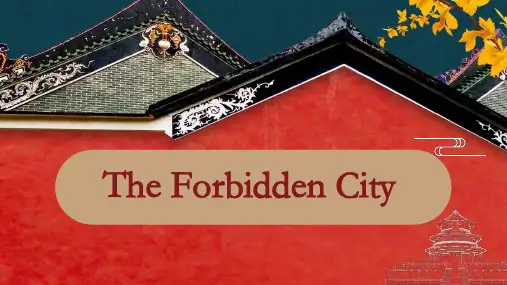
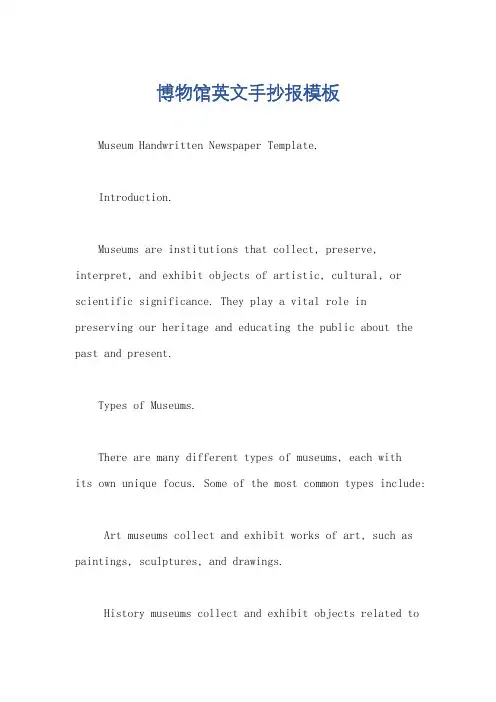
博物馆英文手抄报模板Museum Handwritten Newspaper Template.Introduction.Museums are institutions that collect, preserve, interpret, and exhibit objects of artistic, cultural, or scientific significance. They play a vital role in preserving our heritage and educating the public about the past and present.Types of Museums.There are many different types of museums, each withits own unique focus. Some of the most common types include:Art museums collect and exhibit works of art, such as paintings, sculptures, and drawings.History museums collect and exhibit objects related tohistory, such as artifacts, documents, and photographs.Natural history museums collect and exhibit objects related to the natural world, such as animals, plants, and minerals.Science museums collect and exhibit objects related to science and technology, such as inventions, machines, and experiments.The Importance of Museums.Museums are important for a number of reasons. They:Preserve our heritage. Museums collect and preserve objects that are important to our history and culture. These objects can help us to understand our past and learn from the mistakes and achievements of those who came before us.Educate the public. Museums provide a wealth of information about the past and present. They can help us tolearn about different cultures, different periods of history, and different scientific concepts.Inspire creativity. Museums can inspire creativity by exposing us to new ideas and different ways of thinking. They can also help us to develop our own artistic and intellectual skills.How to Visit a Museum.There are a few things you can do to make the most of your visit to a museum:Plan ahead. Decide which museums you want to visit and what you want to see. You can also check the museum's website to see if they have any special events or exhibitions planned.Take your time. Don't try to rush through a museum. Take your time to look at the exhibits and read the labels. You may also want to take a guided tour to learn more about the museum's collection.Ask questions. If you have any questions, don't be afraid to ask a museum staff member. They are there to help you learn and enjoy your visit.Museums are valuable institutions that play an important role in our society. They preserve our heritage, educate the public, and inspire creativity. The next time you have the chance to visit a museum, take your time and enjoy the experience.中文回答:博物馆手抄报模板。
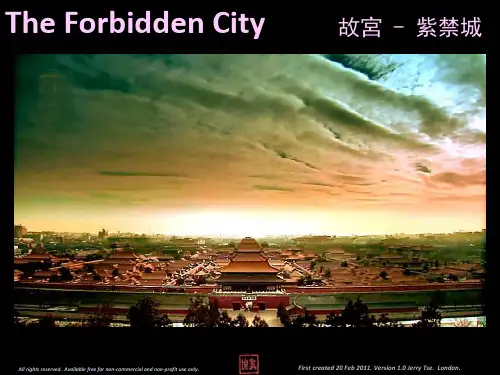
The Forbidden City故宮-紫禁城First created 20 Feb 2011. Version 1.0 Jerry Tse. London.All rights reserved. Available free for non-commercial and non-profit use only.Plan The Outer CourtThe Inner CourtThe palace was divided into twoparts .The Outer Court was usedfor state ceremonies.The Inner Court was the residenceof the Emperor and his family.Itwas also used for running theday-to-day affairs of state.It wasrun by eunuchs.In early Ming Dynasty,there wereabout 1630halls.In early Qingthere were 1800halls.Currentlythe palace has 2631halls and 90courtyards.The Ming Builders 明Zhudi was the third emperor of the Ming Dynasty.He decided to move the capital from Nanjing to Beijing.He was a megalomaniac.Not only did he built the Forbidden City In Beijing,he also restored the Great Wall&the Grand Canal and sent his armada of ships into the Indian Ocean reaching Saudi Arabia and Africa.Zhu Di 朱棣A late 15C to early 16C painting depicting the Heavenly Succession Gate 承天門and the Outer Five Dragons Bridge 外五龍橋near today’s Tiananmen. In1406,he started building the Forbidden City,which took15years to complete in1421,employing200,000 craftsmen and million of labourers to build.It created an architectural complex unmatched in history.It is the biggest palace the world have even seen,with some1630 halls.Unfortunately,it was burned down3times by major fires during the273years of the Ming Dynasty and had to be rebuilt again.Construction MaterialsBricks and Golden Bricks 金磚–Bricks were used for paving and for the external walls.Floor tiles are known as Golden Bricks,made in Suzhou.These were made of clay and took two months firing in kilns.A floor tile took two years to made,and can last for centuries.They are called Golden Bricks because they are expensive to made.Timber –All palace buildings used timber frame structures.The most important of timber are the pillars of Nanwu wood 楠木(Phoebe Zhennan).These logs were transported from south western China and took 4years for the journey.Some 100,000Nanwu pillars were used in the construction.The wood work were covered by a secret formulated paste,mixed with pig’s blood,flour and earth for preservation.Marble 漢白玉石–The main buildings of the palaces were build on marble terraces.There is a huge inclined slab,with carved dragons,weighs 300tons.These were transported on sheets of ice pulled by 20000men and horses and took a month to travel the 50km journey.Glazed Roof Tile –By far the most common roof tiles are the yellow glazed tiles.Yellow being the colour of the emperor.A few houses are covered with green tiles for the princes.Qing 清During the Qing dynasty,the palace was rebuilt many times afterfires.Many buildings were also added to the palace.Below is aview of the palace on the wedding of the Qing Emperor Guangxu.Qianlong 乾隆(1711-95)The longest reigning emperor (1736-95)of Qing Dynasty.He started a60years major upgrade of the palaces.He was a highly cultured emperor,with a diverse range of interests–from collecting jade to calligraphy etc.It was his collection more than any other emperors that form the backbone of the collection of the Qugong Museum in Beijing and of the Palace Museum of Taipei.Under him,imperial China reached the zenith of her power.Moat The palace is surrounded by a52m wide moat.Walls The exterior walls is10m high,8.6m thick at the base.The core of thewall is filled with earth,surfaced with three layers of special bricksCorner Towers 角樓There are four watch towers at the four corners of the palace walls.GatesThere are some 10,000 gates in the palace.Meridian Gate 午門This is the grandest of all the palace gates. It is nearly 38m high. This marks the beginning of the palace complex.Decorative Glazed Tiles 琉璃Apart from the distinctive yellow glazed tiles used forthe roofs,tiles were also used as decorations onscreens and walls.RoofMythical creatureson the roof ridgesshowing the statusof the building.Distinctive yellow glazed tiles makethe palace stand out from the rest ofthe city.Because most Chinese roofs were curved, the timber frame that supported the roof became more complicated.Wooden ConstructionChinese carpenters developedsome of the most complicatedwooden joints used in buildings(see diagram on the right).Oneof these complicated joint is theLuban Locking Joints魯班鎖,which is a joint used for threeperpendicular beams. Timber Frame 梁架Traditional large Chinese buildings were mainly built of wood.Allthe weight of the building are supported by a wooden frame.Thusthe wall are light and not weight bearing.BracketingDougongs are brackets that lockbeams together with pillars together.The technique dated back to twothousand years.斗栱Ceilings Caisson 藻井Coffered ceilings.天花Terraces 台基The use of terraces in Chinese architecture dated back to over 3000years. The three main buildings of the outer court were built on a threetiers of marble terraces decorated with beautiful carved balustrades.Carved Slab The carved slab on the central staircase of the main terrace. Onlythe emperors were allowed to be carried over it.Outer Court外朝During the Ming Dynasty, the Outer Court is used by the emperor to attend the daily affairs of the state.During the Qing Dynasty, this usage was moved to the Inner Court. However, the Outer Court was always used for the special state occasions and ceremonies.The three most important buildings lies on the central north-south axis. They are the Hall of Supreme Harmony太和殿(first building on the photo), the Hall of Central Harmony 中和殿(the small building behind) and the Hall of Preserving Harmony 保和殿.Supreme Harmony 太和殿The original Ming building was twice as large as the current hall. It is oneof the largest wooden structure within China. The building is the focalpoint of the palace. It was used in Ming Dynasty to administration stateaffairs. In Qing Dynasty it was used only for ceremonial occasions.太和殿Hall of Supreme Harmony -InteriorRichly decorated withbeautiful carvings,theDragon Throne stands ona raised platform,surrounding with urns,incense burners,carveddragons,cranes andelephants.Envoys were required tokneel and kowtow to thefloor nine times onapproach to the emperor.Supreme Harmony 太和殿It is the largest timber frame building in China. The building was destroyed 7 times. The last rebuilt was in 1695-1697.Central Harmony中和殿It is small square hall,serving as a rest room.It was a stop over room forthe emperor for last minute preparations before conducting state orceremony affairs.ThroneA beautifully carved dragon standing on the back of the throne.There are several thrones in the palace.They are all beautifully carved.Some are in gold colour and others with natural wood colours.Hall of PreservingHarmony保和殿The hall was used for the‘imperial examination’, as well as banquets on Lunar New Year’s Eve to entertain ministers,generals,as well as Mongolian and Tibetan nobles.Musical Instruments A rack of gilded musical bronze bells used during ceremonial and state occasions.The bells are similar in size and different notes are produced using bells with different thickness.Inner Court 內朝The Gate of Heavenly Purity (above) leading into the Inner Court. The three most important buildings in the Inner Court echoes the group of the three buildings in the Outer Court. They are the Hall of Heavenly Purity 乾清宫(first building on the photo), the Hall of Union 交泰殿(the small building behind) and the Hall of Earthly Tranquillity 坤宁宫.The Inner Court was the home of the Emperor and his family. In Qing Dynasty the some halls within theInner Court were used by for administering state affairs.The Gate of HeavenlyPurity乾清門Entrance to the private world of the emperor.Palace of Heavenly Purity乾清宫In early Qing Dynasty and Ming Dynasty,it ishere that the emperor conducted the day-to-day affairs.In late Qing,it was used as anaudience hall to receive foreign envoys andhigh ranked officials.Hall of Union交泰殿The building was used as the empress’dressingroom or celebrations of her birthdays.Theimperial seals were also kept in here in Qing.Clepsydra (Water clock) The main mechanism of the water clock consists of three copper containers filled with water.Water drips from the top container to containers below in turn.The amount of water collected at the bottom is used to tell the time.Hall of Earthly Tranquillity坤寧宫The last of the Inner Court halls.Hall of Earthly Tranquillity坤寧宫In Ming Dynasty,thebuilding was used asthe residence of theempress.In Qing it wasconverted into severalrooms and set out inManchurian style forreligious services.Thebuilding included akitchen for preparingfood for worship.Italso has a bridal roomand a study for theemperor.The Qing emperor Yongzhen 雍正moved the emperor residence here.The empress Dowager Cixi 慈禧(reign1861-1908)used the place to received state officials and ruled China.Hall of Mental Cultivation 養心殿Hall of Mental Cultivation養心殿The main reception room where later Qing emperors attended state affairs.Hall of Mental Cultivation養心殿This is the Cixi慈禧throne room.Behind the screen of the throne was another throne,on which the Dowager Empress ruled China.Hall of Mental Cultivation養心殿This was the emperor’s bedroom behind the reception room of the Hall of Mental Cultivation.Imperial Garden御花園There are four gardens in the Inner Courtof the palace. The Imperial Garden beingthe largest of them all.A giant incense burner in the garden.Imperial GardenPavilion of Imperial Prospect overlooking the garden. 御景亭御花園Imperial Garden御花園Studio of Spiritual Cultivation. 養性齋Imperial Gardens御花園This is the First Gate of Heaven天一門.Court LifeEmperor Qianlong watching princes playing in snow.To maintain the palace during the QingDynasty,280,000taels of silver wereneeded each year or approximately340,000troy ounces ofsilver.Last emperor and empress of China.Theatre –Pavillion of Pleasant Sounds, 暢音閣.The largest stage of the three stories theatre in the palace.Painted decorationsSuzhou style polychrome painted decorationsPainted beams and bracketsBronze Animal sculpturesBronze tortoise incense burner.Gilt bronzeelephant in thegarden.Gilt bronze lion.Bronze lion at the Gate of Supreme Harmony.Doors decorationsGate of Martial Spirit.Hall of Union.Carved panelon the doors atthe Hall ofImperialSupremacyHall of Mental CultivationQugong Museum The Forbidden City is also the home to the Palace Museum, Beijing.Music –Flying Dragons and Jumping Tiger 龍騰虎跃composed by Li Minxiong李民進and performed by HongKong Chinese Orchestra.The EndAdvance to next slide to see briefnotes on Chinese architecture.Chinese Traditional Palatial (Dian 殿) Architecture Chinese architecture uses modular architectural plan.Buildings are connected by corridors or unified by courtyards.Buildings are not integrated to form a larger building.Using timber as primary building material,this is the most important single characteristics of Chinese architectural approach.Transportation costs can be very ing timber also put a limit on the size,the height and the age of buildings. The availability of large hard wood timber is also a limitation.Chinese Dian buildings are based on a timber frame.The walls of the buildings are not weight bearing.This allows more light and airy interior.Buildings are cool in summer but difficult to keep warm in winter.Buildings are inherent‘earthquake proof’.To give the timber frame strength,interlocking joints were developed to a very high level of sophistication.This can be seen in the Dougong bracketing techniques.The basic principles and architectural design did not changed much for centuries.Chinese buildings are very colourful and timber does not preserved well.The maintenance costs are very high.Finally Chinese buildings are very vulnerable to fire.The Hall of Supreme Harmony was rebuilt7times,in500years.TimelineThe End Carved dragon on wooden screen behind the throne.。
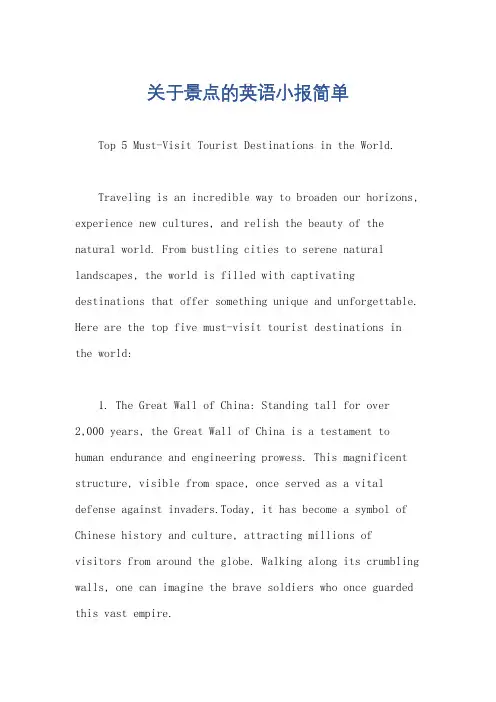
关于景点的英语小报简单Top 5 Must-Visit Tourist Destinations in the World.Traveling is an incredible way to broaden our horizons, experience new cultures, and relish the beauty of the natural world. From bustling cities to serene natural landscapes, the world is filled with captivating destinations that offer something unique and unforgettable. Here are the top five must-visit tourist destinations in the world:1. The Great Wall of China: Standing tall for over2,000 years, the Great Wall of China is a testament to human endurance and engineering prowess. This magnificent structure, visible from space, once served as a vital defense against invaders.Today, it has become a symbol of Chinese history and culture, attracting millions ofvisitors from around the globe. Walking along its crumbling walls, one can imagine the brave soldiers who once guarded this vast empire.2. The Eiffel Tower, Paris: Standing tall and elegantin the heart of Paris, the Eiffel Tower is a symbol of love, romance, and French culture. Built for the 1889 World's Fair, the tower offers breathtaking views of the cityscape and the surrounding region. Visitors can take a ride to the top for a panoramic view or enjoy a romantic dinner at oneof the tower's restaurants. The Eiffel Tower is a must-visit for anyone who wants to experience the charm and elegance of Paris.3. The Pyramids of Giza, Egypt: Built more than 4,500 years ago, the Pyramids of Giza are the oldest and largestof the seven ancient wonders of the world. Thesemagnificent structures, made of millions of blocks of stone, were built as tombs for the ancient Egyptian kings.Visiting the Pyramids, one can marvel at the incrediblefeat of engineering and the enduring mystery that surrounds them.4. The Great Barrier Reef, Australia: The Great Barrier Reef is the largest coral reef system in the world,covering an area of over 344,000 square kilometers. This水下 wonderland is home to an abundance of marine life, including colorful coral, tropical fish, and marine mammals. Snorkeling or diving in the Reef is an otherworldly experience that allows visitors to appreciate the beautyand diversity of the underwater world.5. Machu Picchu, Peru: Nestled in the Andes Mountainsof Peru, Machu Picchu is an ancient Inca city that was rediscovered by the world in 1911. This lost city of goldis considered one of the most important archaeologicalsites in the world. The site is filled with incrediblestone structures, including temples, palaces, and fortresses, all built without the use of mortar or wheels. Hiking to Machu Picchu is a challenging but rewarding experience that offers breathtaking views of thesurrounding mountains and valleys.Traveling to these destinations is not just aboutseeing the sights; it's about immersing oneself in the culture, history, and beauty of each place. From theancient wonders of Egypt to the modern marvels ofengineering in China, the world is full of incredible places waiting to be discovered. So, pack your bags, put on your most comfortable shoes, and start exploring the beauty and wonders of the world.。
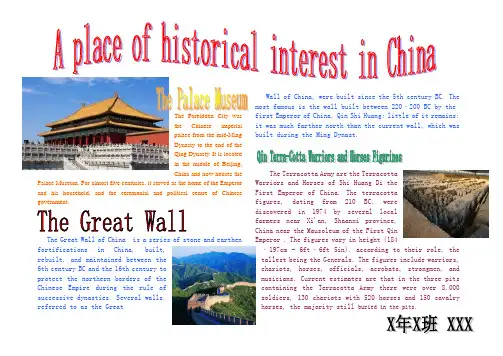
The Forbidden City was theChineseimperialpalace from the mid-Ming Dynasty to the end of the Qing Dynasty. It is located in the middle of Beijing, China and now houses thePalace Museum. For almost five centuries, it served as the home of the Emperor and his household, and the ceremonial and political centre of Chinese government.The Great Wall of China is a series of stone and earthen fortifications in China, built, rebuilt, and maintained between the 6th century BC and the 16th century to protect the northern borders of the Chinese Empire during the rule of successive dynasties. Several walls, referred to as the GreatWall of China, were built since the 5th century BC. The most famous is the wall built between 220–200 BC by the first Emperor of China, Qin Shi Huang; little of it remains; it was much farther north than the current wall, which was built during the Ming Dynast.The Terracotta Army are the Terracotta Warriors and Horses of Shi Huang Di the First Emperor of China. The terracotta figures, dating from 210 BC, were discovered in 1974 by several local farmers near Xi'an, Shaanxi province, China near the Mausoleum of the First Qin Emperor . The figures vary in height (184–197cm - 6ft –6ft 5in), according to their role, the tallest being the Generals. The figures include warriors, chariots, horses, officials, acrobats, strongmen, and musicians. Current estimates are that in the three pits containing the Terracotta Army there were over 8,000 soldiers, 130 chariots with 520 horses and 150 cavalry horses, the majority still buried in the pits.。
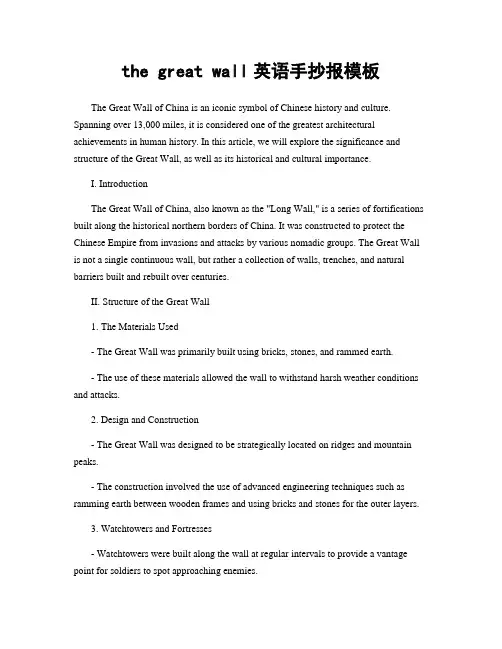
the great wall英语手抄报模板The Great Wall of China is an iconic symbol of Chinese history and culture. Spanning over 13,000 miles, it is considered one of the greatest architectural achievements in human history. In this article, we will explore the significance and structure of the Great Wall, as well as its historical and cultural importance.I. IntroductionThe Great Wall of China, also known as the "Long Wall," is a series of fortifications built along the historical northern borders of China. It was constructed to protect the Chinese Empire from invasions and attacks by various nomadic groups. The Great Wall is not a single continuous wall, but rather a collection of walls, trenches, and natural barriers built and rebuilt over centuries.II. Structure of the Great Wall1. The Materials Used- The Great Wall was primarily built using bricks, stones, and rammed earth.- The use of these materials allowed the wall to withstand harsh weather conditions and attacks.2. Design and Construction- The Great Wall was designed to be strategically located on ridges and mountain peaks.- The construction involved the use of advanced engineering techniques such as ramming earth between wooden frames and using bricks and stones for the outer layers.3. Watchtowers and Fortresses- Watchtowers were built along the wall at regular intervals to provide a vantage point for soldiers to spot approaching enemies.- Fortresses were constructed at key locations to house troops and store supplies.III. Historical Significance1. Defense Against Invasions- The Great Wall served as a formidable defense system, protecting China from invasions by Mongols, Turks, and other nomadic tribes.- It acted as a physical barrier, making it difficult for enemies to breach the wall and invade Chinese territories.2. Symbol of Chinese Unity- The construction of the Great Wall was a massive national project that required the efforts of millions of workers.- It symbolized the unity and determination of the Chinese people to protect their homeland.3. Cultural Heritage- The Great Wall is not only a physical structure but also a symbol of Chinese history and culture.- It has become a UNESCO World Heritage Site and attracts millions of tourists every year.IV. Cultural Importance1. Tourism and Economy- The Great Wall has become one of China's most popular tourist destinations, contributing significantly to the country's tourism industry.- The influx of tourists has also led to the development of hotels, restaurants, and other businesses in the surrounding areas.2. Art and Literature- The Great Wall has inspired countless artists, writers, and poets throughout history.- It has been depicted in various forms of art, literature, and even in films, showcasing its cultural significance.3. Symbol of Perseverance- The Great Wall represents the determination and perseverance of the Chinese people.- It serves as a reminder of the challenges overcome during its construction and the strength of the Chinese civilization.V. ConclusionThe Great Wall of China stands as a testament to the ingenuity, strength, and cultural richness of the Chinese civilization. Its structure, historical significance, and cultural importance make it a remarkable achievement in human history. As a symbol of unity and defense, the Great Wall continues to inspire and captivate people from all around the world.。
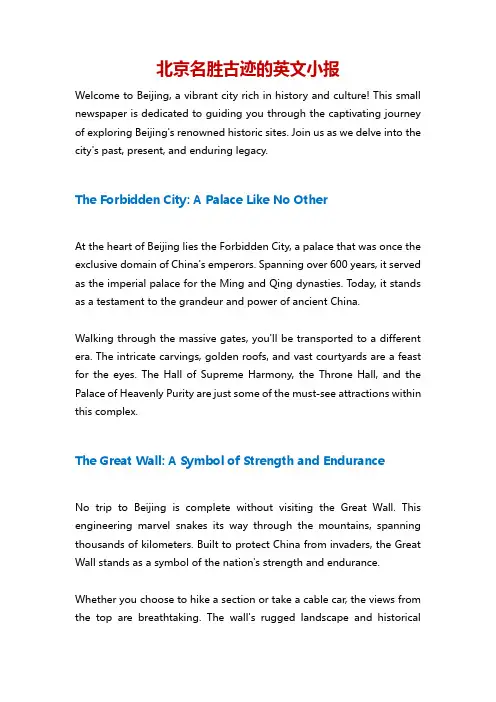
北京名胜古迹的英文小报Welcome to Beijing, a vibrant city rich in history and culture! This small newspaper is dedicated to guiding you through the captivating journey of exploring Beijing's renowned historic sites. Join us as we delve into the city's past, present, and enduring legacy.The Forbidden City: A Palace Like No OtherAt the heart of Beijing lies the Forbidden City, a palace that was once the exclusive domain of China's emperors. Spanning over 600 years, it served as the imperial palace for the Ming and Qing dynasties. Today, it stands as a testament to the grandeur and power of ancient China.Walking through the massive gates, you'll be transported to a different era. The intricate carvings, golden roofs, and vast courtyards are a feast for the eyes. The Hall of Supreme Harmony, the Throne Hall, and the Palace of Heavenly Purity are just some of the must-see attractions within this complex.The Great Wall: A Symbol of Strength and EnduranceNo trip to Beijing is complete without visiting the Great Wall. This engineering marvel snakes its way through the mountains, spanning thousands of kilometers. Built to protect China from invaders, the Great Wall stands as a symbol of the nation's strength and endurance.Whether you choose to hike a section or take a cable car, the views from the top are breathtaking. The wall's rugged landscape and historicalsignificance make it a truly unforgettable experience.The Temple of Heaven: A Sacred SiteThe Temple of Heaven, originally built for the emperors to worship heaven and pray for good harvests, is another must-visit historic site in Beijing. This complex of temples and altars is a masterpiece of ancient Chinese architecture and landscape design.The Hall of Prayer for Good Harvests, with its blue-tiled roof and circular base, is particularly striking. The surrounding park, with its ancient cypress trees and peaceful atmosphere, is a great place to relax and reflect.The Summer Palace: A Royal RetreatThe Summer Palace, located in the northwestern suburbs of Beijing, was once a royal retreat for the emperors and their families. This vast garden complex, filled with lakes, bridges, pavilions, and temples, is a testament to the opulence and elegance of the imperial era.A boat ride on Kunming Lake, a stroll through the Long Corridor, or a visit to the Marble Boat are just some of the many activities you can enjoy here. The Summer Palace is a perfect blend of natural beauty and man-made wonders.The Hutongs: A Glimpse into Old BeijingNo visit to Beijing is complete without exploring its hutongs. Thesenarrow lanes, lined with traditional siheyuan (four-sided compounds), offer a glimpse into the city's past. Walking through the hutongs, you'll get a sense of the old Beijing lifestyle and the city's rich cultural heritage.A rickshaw ride through the hutongs, a visit to a local teahouse, or simply wandering aimlessly are great ways to immerse yourself in this unique aspect of Beijing's history and culture.In ConclusionBeijing, with its wealth of historic sites and cultural attractions, offers something for everyone. Whether you're fascinated by ancient architecture, interested in imperial history, or simply looking for a unique travel experience, Beijing has it all. So, pack your bags and get ready to embark on a journey through time in this captivating city!。
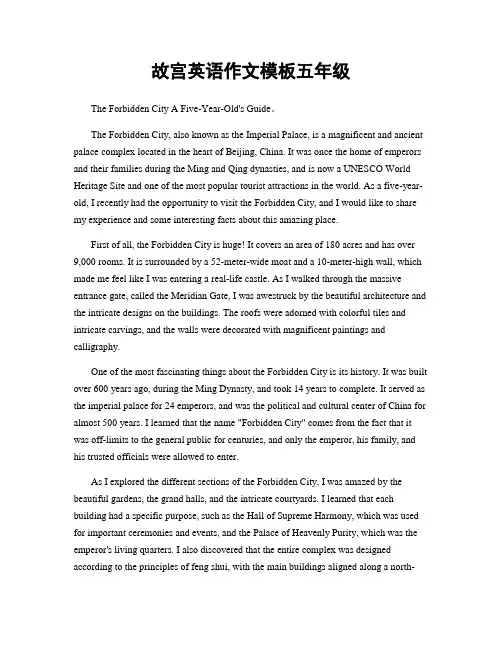
故宫英语作文模板五年级The Forbidden City A Five-Year-Old's Guide。
The Forbidden City, also known as the Imperial Palace, is a magnificent and ancient palace complex located in the heart of Beijing, China. It was once the home of emperors and their families during the Ming and Qing dynasties, and is now a UNESCO World Heritage Site and one of the most popular tourist attractions in the world. As a five-year-old, I recently had the opportunity to visit the Forbidden City, and I would like to share my experience and some interesting facts about this amazing place.First of all, the Forbidden City is huge! It covers an area of 180 acres and has over 9,000 rooms. It is surrounded by a 52-meter-wide moat and a 10-meter-high wall, which made me feel like I was entering a real-life castle. As I walked through the massive entrance gate, called the Meridian Gate, I was awestruck by the beautiful architecture and the intricate designs on the buildings. The roofs were adorned with colorful tiles and intricate carvings, and the walls were decorated with magnificent paintings and calligraphy.One of the most fascinating things about the Forbidden City is its history. It was built over 600 years ago, during the Ming Dynasty, and took 14 years to complete. It served as the imperial palace for 24 emperors, and was the political and cultural center of China for almost 500 years. I learned that the name "Forbidden City" comes from the fact that it was off-limits to the general public for centuries, and only the emperor, his family, and his trusted officials were allowed to enter.As I explored the different sections of the Forbidden City, I was amazed by the beautiful gardens, the grand halls, and the intricate courtyards. I learned that each building had a specific purpose, such as the Hall of Supreme Harmony, which was used for important ceremonies and events, and the Palace of Heavenly Purity, which was the emperor's living quarters. I also discovered that the entire complex was designed according to the principles of feng shui, with the main buildings aligned along a north-south axis and the surrounding landscape carefully planned to create a harmonious balance.One of the highlights of my visit was seeing the imperial throne in the Hall of Preserving Harmony. It was made of precious materials such as gold, jade, and precious stones, and was adorned with intricate carvings and designs. I was amazed to learn that the throne was used by the emperors for important ceremonies and was a symbol of their power and authority.Another interesting aspect of the Forbidden City is its collection of art and artifacts. I saw beautiful paintings, sculptures, and ceramics that were created by some of the most talented artists in Chinese history. I also learned about the imperial treasures, including the emperor's robes, crowns, and jewelry, which were made of the finest materials and adorned with exquisite designs.In conclusion, my visit to the Forbidden City was an unforgettable experience. I was fascinated by the rich history, the stunning architecture, and the beautiful art and artifacts.I also learned a lot about the ancient Chinese culture and the traditions of the imperial court. I would highly recommend a visit to the Forbidden City to anyone who is interested in history, art, or architecture. It is truly a treasure of the world and a must-see destination for people of all ages.。
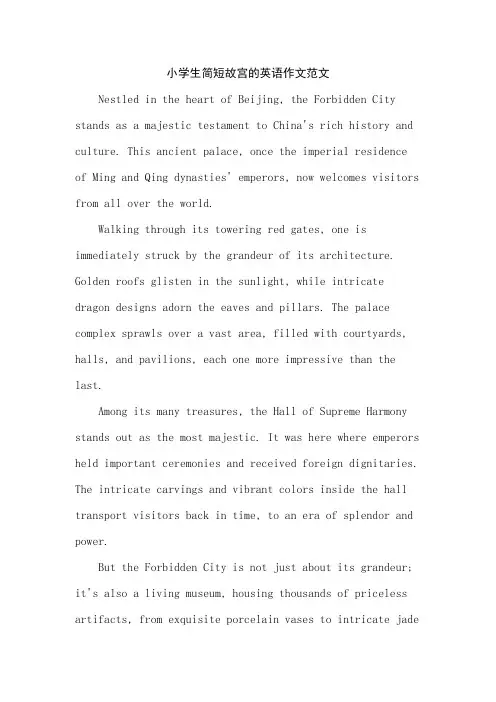
小学生简短故宫的英语作文范文Nestled in the heart of Beijing, the Forbidden City stands as a majestic testament to China's rich history and culture. This ancient palace, once the imperial residence of Ming and Qing dynasties' emperors, now welcomes visitors from all over the world.Walking through its towering red gates, one is immediately struck by the grandeur of its architecture. Golden roofs glisten in the sunlight, while intricate dragon designs adorn the eaves and pillars. The palace complex sprawls over a vast area, filled with courtyards, halls, and pavilions, each one more impressive than the last.Among its many treasures, the Hall of Supreme Harmony stands out as the most majestic. It was here where emperors held important ceremonies and received foreign dignitaries. The intricate carvings and vibrant colors inside the hall transport visitors back in time, to an era of splendor and power.But the Forbidden City is not just about its grandeur; it's also a living museum, housing thousands of priceless artifacts, from exquisite porcelain vases to intricate jadecarvings. Each piece tells a story, shedding light on the lives and tastes of China's ancient rulers.A visit to the Forbidden City is a journey through time, a chance to glimpse into the lives of emperors long gone and to marvel at the remarkable achievements of Chinese civilization.。
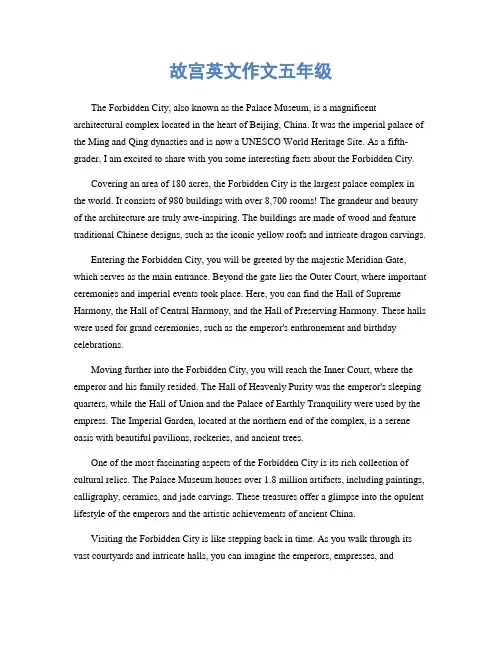
故宫英文作文五年级The Forbidden City, also known as the Palace Museum, is a magnificent architectural complex located in the heart of Beijing, China. It was the imperial palace of the Ming and Qing dynasties and is now a UNESCO World Heritage Site. As a fifth-grader, I am excited to share with you some interesting facts about the Forbidden City.Covering an area of 180 acres, the Forbidden City is the largest palace complex in the world. It consists of 980 buildings with over 8,700 rooms! The grandeur and beauty of the architecture are truly awe-inspiring. The buildings are made of wood and feature traditional Chinese designs, such as the iconic yellow roofs and intricate dragon carvings.Entering the Forbidden City, you will be greeted by the majestic Meridian Gate, which serves as the main entrance. Beyond the gate lies the Outer Court, where important ceremonies and imperial events took place. Here, you can find the Hall of Supreme Harmony, the Hall of Central Harmony, and the Hall of Preserving Harmony. These halls were used for grand ceremonies, such as the emperor's enthronement and birthday celebrations.Moving further into the Forbidden City, you will reach the Inner Court, where the emperor and his family resided. The Hall of Heavenly Purity was the emperor's sleeping quarters, while the Hall of Union and the Palace of Earthly Tranquility were used by the empress. The Imperial Garden, located at the northern end of the complex, is a serene oasis with beautiful pavilions, rockeries, and ancient trees.One of the most fascinating aspects of the Forbidden City is its rich collection of cultural relics. The Palace Museum houses over 1.8 million artifacts, including paintings, calligraphy, ceramics, and jade carvings. These treasures offer a glimpse into the opulent lifestyle of the emperors and the artistic achievements of ancient China.Visiting the Forbidden City is like stepping back in time. As you walk through its vast courtyards and intricate halls, you can imagine the emperors, empresses, andconcubines who once lived here. The palace complex is a living testament to China's imperial history and its enduring cultural heritage.In recent years, the Forbidden City has become a popular tourist destination, attracting millions of visitors from around the world. To preserve its historical and cultural significance, strict conservation measures have been implemented. The Palace Museum conducts ongoing restoration projects to ensure the longevity of the buildings and the preservation of the artifacts.In conclusion, the Forbidden City is a remarkable symbol of China's imperial past. Its grand architecture, rich history, and cultural treasures make it a must-visit destination for anyone interested in Chinese history and culture. As a fifth-grader, I feel fortunate to have the opportunity to learn about and appreciate this magnificent palace complex. I hope that more people will have the chance to explore the wonders of the Forbidden City and experience its timeless beauty.。
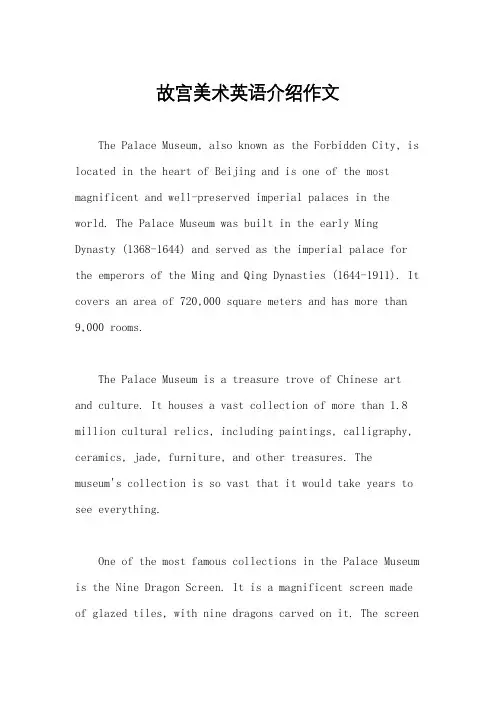
故宫美术英语介绍作文The Palace Museum, also known as the Forbidden City, is located in the heart of Beijing and is one of the most magnificent and well-preserved imperial palaces in the world. The Palace Museum was built in the early Ming Dynasty (1368-1644) and served as the imperial palace for the emperors of the Ming and Qing Dynasties (1644-1911). It covers an area of 720,000 square meters and has more than 9,000 rooms.The Palace Museum is a treasure trove of Chinese art and culture. It houses a vast collection of more than 1.8 million cultural relics, including paintings, calligraphy, ceramics, jade, furniture, and other treasures. The museum's collection is so vast that it would take years to see everything.One of the most famous collections in the Palace Museum is the Nine Dragon Screen. It is a magnificent screen made of glazed tiles, with nine dragons carved on it. The screenis 27 meters long, 3.5 meters high, and 1 meter thick. Itis said to be the largest glazed tile screen in China.Another highlight of the Palace Museum is the Hall of Supreme Harmony. It is the largest and most important hall in the Forbidden City, and was where the emperors heldtheir most important ceremonies. The hall is 35 meters high and covers an area of 2,377 square meters. The hall is decorated with intricate carvings and paintings, and is a masterpiece of Chinese architecture.The Palace Museum is not only a museum but also a window into China's rich history and culture. It is a must-visit destination for anyone interested in Chinese art and history. The museum is open to the public every day except Mondays, and tickets can be purchased online or at the museum's ticket office. Visitors are advised to arrive early to avoid the crowds, especially during peak tourist season.In conclusion, the Palace Museum is a national treasure of China and a world-renowned cultural heritage site. It isa testament to the ingenuity and creativity of the Chinese people, and a symbol of their rich and diverse cultural heritage. A visit to the Palace Museum is an unforgettable experience that will leave visitors with a deeper appreciation of Chinese art, culture, and history.。
绘制故宫的名片英文作文英文:As a tourist destination, the Palace Museum, also known as the Forbidden City, is a must-visit attraction in Beijing. The Palace Museum is a complex of magnificent imperial palaces, exquisite courtyards, and beautiful gardens that served as the home of emperors and their households for over 500 years.The Palace Museum is a UNESCO World Heritage site that attracts millions of visitors from all over the world every year. It is a symbol of China's rich cultural heritage and history, and it offers a glimpse into the opulent lifestyle of the Chinese imperial family.One of the most impressive features of the Palace Museum is its architecture. The buildings are grand and imposing, with intricate carvings and decorations that reflect the sophistication and elegance of traditionalChinese culture. The Palace Museum is also home to a vast collection of art and artifacts, including paintings, calligraphy, ceramics, and jade.In addition to its historical and cultural significance, the Palace Museum is also a popular destination for modern-day events and activities. It hosts exhibitions, concerts, and performances throughout the year, and it is a popular spot for weddings, fashion shoots, and other special events.中文:作为旅游目的地,故宫博物院,也被称为紫禁城,是北京必去的景点之一。
本文部分内容来自网络整理,本司不为其真实性负责,如有异议或侵权请及时联系,本司将立即删除!== 本文为word格式,下载后可方便编辑和修改! ==故宫英文介绍ppt篇一:故宫介绍英语Royal Family Enjoying Autumn The painting is inscribed “Enjoying Autumn in the Courtyard” with two seals: “Daoguang Emperor’s Treasure” and “Imperial Palace Collection”.Depicting domestic peace and pleasant family life, the painting shows the Daoguang Emperor and his chief consort admiring the beauty of autumn with their children playing in the courtyard. The autumn is indicated through chrysanthemums in full bloom and red maple leaves. The emperor and empress are sitting in a pavilion while a prince anda princess are playing on the stone steps.In the foreground of the courtyard is an imperial concubine holding the hand of a young prince. Nearby are a maid, a princess and a lady-in-waiting. The picture follows the principles of western perspective yet the figures follow the Chinese tradition that figures of higher rank are bigger while ones of lower status are more diminutive.这幅画是刻有“享受秋天在大院”和两个密封:“道光皇帝的宝”和“故宫收藏”。
本文部分内容来自网络整理,本司不为其真实性负责,如有异议或侵权请及时联系,本司将立即删除!== 本文为word格式,下载后可方便编辑和修改! ==故宫英文介绍ppt篇一:故宫介绍英语Royal Family Enjoying Autumn The painting is inscribed “Enjoying Autumn in the Courtyard” with two seals: “Daoguang Emperor’s Treasure” and “Imperial Palace Collection”.Depicting domestic peace and pleasant family life, the painting shows the Daoguang Emperor and his chief consort admiring the beauty of autumn with their children playing in the courtyard. The autumn is indicated through chrysanthemums in full bloom and red maple leaves. The emperor and empress are sitting in a pavilion while a prince anda princess are playing on the stone steps.In the foreground of the courtyard is an imperial concubine holding the hand of a young prince. Nearby are a maid, a princess and a lady-in-waiting. The picture follows the principles of western perspective yet the figures follow the Chinese tradition that figures of higher rank are bigger while ones of lower status are more diminutive.这幅画是刻有“享受秋天在大院”和两个密封:“道光皇帝的宝”和“故宫收藏”。
故宫英文版介绍1The Forbidden City, a remarkable masterpiece of ancient architecture and a symbol of China's profound cultural heritage, stands as a testament to the ingenuity and grandeur of the past. It was built during the Ming Dynasty in the 15th century and has witnessed the rise and fall of numerous dynasties.The architectural style of the Forbidden City is truly breathtaking! The red walls and yellow glazed tiles, along with the exquisite upturned eaves and dougong brackets, showcase the exquisite craftsmanship and aesthetic pursuit of that era. The palatial layout is a wonder in itself. How magnificent it is to see the orderly arrangement of palaces and courtyards!The Forbidden City houses an astonishing collection of precious cultural relics. These treasures, such as ancient calligraphy, paintings, and exquisite handicrafts, not only represent the artistic achievements of ancient times but also carry profound cultural meanings. They tell stories of the past and offer a glimpse into the wisdom and creativity of our ancestors.Oh, the Forbidden City is not just a group of buildings; it is a living history book! Isn't it a wonder that it has endured through the ages and still captivates our hearts and minds today?2Oh my goodness! The Forbidden City is truly a wonder of the world. When you step into it, you are immediately transported to a world of ancient grandeur and mystery.Imagine walking along the central axis of the Forbidden City. The solemn and majestic atmosphere surrounds you. The magnificent buildings stand tall and proud, as if telling stories of the past. You can't help but gasp in awe at the sheer scale and beauty of it all!And then there are the palaces. When you enter one, you are greeted by exquisite artworks. The craftsmanship is simply astonishing! How could the ancient artisans create such masterpieces? The detailed carvings, the vibrant colors, they all leave you speechless.The Forbidden City is not just a collection of buildings and art. It is a living history. It shows us the wisdom and creativity of our ancestors. Every corner, every brick, every piece of art holds a story. Isn't it amazing? It's a place that makes you feel small yet connected to something so much bigger and more profound.So, come and explore the Forbidden City. Let it touch your soul and fill your heart with wonder and respect for our heritage.3The Forbidden City, located in the heart of Beijing, China, is aremarkable place that holds great significance in the world's cultural heritage! It was once the imperial palace of the Ming and Qing dynasties and is now a major tourist attraction and a symbol of China's rich history and culture.The Forbidden City is a vast complex of palaces and buildings, each with its own unique architecture and historical value. It is not just a collection of structures but a living testament to the past! The intricate designs, exquisite decorations, and the grandeur of the buildings are truly breathtaking.It is of immense importance as a world cultural heritage. It showcases the wisdom and craftsmanship of ancient Chinese people. Its influence spreads far and wide across the globe, attracting millions of international visitors every year.The Forbidden City is open from 8:30 am to 5:00 pm. When visiting, you can start from the Meridian Gate and follow the designated route to explore the various halls and courtyards. Don't miss the Hall of Supreme Harmony, the Hall of Central Harmony, and the Hall of Preserving Harmony!In conclusion, the Forbidden City is not only a historical masterpiece but also a source of pride for China. So, come and experience the wonder of this magnificent place!The Forbidden City, a masterpiece of ancient Chinese architecture, stands as a testament to the ingenuity and wisdom of our ancestors. Its architectural structure and design concepts are truly remarkable!The fire prevention system of the Forbidden City is a wonder. For instance, the wide courtyards and the use of materials like stone and brick helped prevent the spread of fire. And how about the drainage system? It's incredibly sophisticated. The carefully designed channels and gutters ensured that rainwater was efficiently drained away, protecting the buildings from damage.The buildings in the Forbidden City also vividly reflect the ancient Chinese hierarchy and aesthetic concepts. The different sizes and styles of palaces and halls indicated the varying ranks and importance of the occupants. The elaborate decorations and symmetrical layouts not only demonstrated the pursuit of beauty but also emphasized the solemnity and dignity of the imperial power! Isn't it astonishing how these elements were combined so seamlessly?The Forbidden City is not just a collection of buildings; it is a living history that continues to inspire and amaze us. How fortunate we are to have such a precious heritage!The Forbidden City, standing majestically in the heart of Beijing, is not just a collection of ancient buildings; it is a living testament to China's glorious past and rich cultural heritage! How remarkable it is!Throughout history, it witnessed numerous significant events. For instance, it was the stage where emperors made crucial decisions that shaped the destiny of the nation. Can you imagine the weight of those decisions made within its walls? It also endured the passage of time, witnessing the transformation of Chinese society from one era to another.In modern times, the Forbidden City plays a vital role in cultural inheritance and innovation. It attracts millions of tourists from all over the world every year. They come to marvel at its beauty and soak in its historical significance. Moreover, various cultural activities and exhibitions are held here, breathing new life into ancient traditions. Isn't it wonderful how it continues to inspire and educate us?The Forbidden City is not just a symbol of the past; it is a bridge connecting the past with the present and the future. Let us cherish and protect this invaluable treasure for generations to come!。
故宫英文海报作文Title: The Forbidden City: A Glimpse into China's Imperial Majesty。
Nestled in the heart of Beijing lies a treasure trove of Chinese history and culture, a magnificent architectural marvel that has withstood the test of time: the Forbidden City. As one of China's most iconic landmarks, the Forbidden City, also known as the Palace Museum, stands as a testament to the grandeur and legacy of imperial China.The Forbidden City, spanning over 180 acres and boasting more than 9,000 rooms, served as the imperial palace for nearly 500 years, from the Ming Dynasty to the end of the Qing Dynasty. Its construction began in 1406 under the Ming Emperor Yongle, and it was completed fourteen years later in 1420. Surrounded by a moat and towering walls, the Forbidden City was aptly named as it was once off-limits to all but the emperor, his family, and his court, creating an aura of mystery and exclusivity.Stepping through the majestic Meridian Gate, visitors are transported back in time to an era of emperors and dynasties. The architectural splendor of the Forbidden City is unparalleled, with its intricate wooden carvings, majestic halls, and sprawling courtyards. Each building isa masterpiece of Chinese architecture, meticulouslydesigned and adorned with vibrant colors and intricate motifs, symbolizing prosperity, longevity, and good fortune.One of the most remarkable features of the ForbiddenCity is its meticulous layout, which reflects the ancient Chinese belief in harmony between heaven and earth. The complex is divided into two main sections: the Outer Court, where grand ceremonies and state affairs took place, andthe Inner Court, which housed the emperor's living quarters and the imperial family's residences. Every detail of the Forbidden City, from its symmetrical design to the placement of its halls and pavilions, was carefully planned to reflect the hierarchical structure of imperial society and the emperor's supreme authority.As visitors wander through the labyrinthine corridors and expansive courtyards of the Forbidden City, they are surrounded by a wealth of historical artifacts and treasures. The Palace Museum boasts a vast collection of over 1.8 million artworks and artifacts, including ancient paintings, ceramics, jade sculptures, and imperial treasures. These priceless treasures offer a glimpse into the opulence and sophistication of imperial life, showcasing the exquisite craftsmanship and artistic mastery of generations past.In addition to its historical significance, the Forbidden City holds a special place in the hearts of the Chinese people as a symbol of national pride and cultural heritage. Despite enduring centuries of wars, invasions, and political upheaval, the Forbidden City has stood as a resilient symbol of China's enduring civilization, serving as a source of inspiration and fascination for people around the world.Today, the Forbidden City continues to captivate visitors from all corners of the globe, offering a windowinto China's rich cultural heritage and imperial legacy. Whether exploring its magnificent halls, admiring its priceless treasures, or simply soaking in its timeless beauty, a visit to the Forbidden City is a journey through history like no other. As we marvel at its grandeur and significance, we are reminded of the enduring legacy of China's imperial past and the timeless allure of the Forbidden City.。
小学英文作文介绍北京故宫50字The Forbidden City, also known as the Palace Museum, is a majestic andhistoric palace complex situated in the heart of Beijing, China. It served as the imperial palace for 24 emperors throughout the Ming and Qing dynasties, spanning over 500 years of Chinese history. The Forbidden City is a symbol of China's rich cultural heritage and is one of the most visited tourist attractions globally.Stepping through the iconic Meridian Gate, visitors are transported back in time to a world of grandeur and opulence. The sprawling complex covers 180 acres and consists of 980 buildings, with over 8,700 rooms filled with priceless artifacts, exquisite artwork, and stunning architecture. The intricate carvings, colorful paintings, and ornate decorations showcase the craftsmanship andattention to detail of ancient Chinese artisans.Walking through the vast courtyards and halls, one can't help but feel a sense of awe and wonder at the sheer scale and magnificence of the Forbidden City. The Hall of Supreme Harmony, the Hall of Central Harmony, and the Hall of Preserving Harmony are just a few of the many impressive structures that make up this architectural marvel. Each building tells a story of power, prestige, and tradition, offering a glimpse into the lives of China's emperors and their court.The Forbidden City is not only a historical site but also a cultural treasure trove, housing over 1.8 million artifacts that reflect China's rich and diverse heritage. From ancient calligraphy and paintings to imperial robes and jade carvings, the Palace Museum offers a comprehensive look at the art and culture of imperial China. Visitors can explore the various exhibitions and galleries to learn about the history of the Forbidden City and its significance in Chinese history.In addition to its cultural significance, the Forbidden City is also a symbol of resilience and survival. Despite facing numerous challenges and threats throughout the centuries, such as wars, invasions, and natural disasters, the palace complex has withstood the test of time and stands as a testament to the enduring spirit of the Chinese people. The meticulous restoration and preservation efforts carried out by the Chinese government have guaranteed that futuregenerations can continue to appreciate and learn from this architectural masterpiece.Visiting the Forbidden City is a truly unforgettable experience that offers a glimpse into China's imperial past and its enduring legacy. The sheer scale and grandeur of the palace complex are awe-inspiring, and the rich history and cultural significance make it a must-see destination for anyone interested in Chinese history and culture. Whether you're a history buff, an art enthusiast, or simply a curious traveler, the Forbidden City offers something for everyone to enjoy and appreciate.。
故宫英语小报模板:
Title: The Forbidden City Times
Headline:
- The Forbidden City: A Spectacular Palace Complex
- The Secrets of the Palace Revealed
- Exploring the Rich History of the Forbidden City
Introduction:
The Forbidden City, also known as the Palace Museum, is a magnificent palace complex located in the heart of Beijing, China. It was the home of Chinese emperors and their families for over 500 years, from the Ming Dynasty to the end of the Qing Dynasty. Today, it is a popular tourist destination and a must-see for anyone interested in Chinese history and culture.
Article 1: The Forbidden City: A Spectacular Palace Complex
The Forbidden City, with its impressive red walls and golden roofs, is a true wonder to behold. It covers an area of 720,000 square meters and contains over 9000 rooms. The palace complex is divided into two parts: the Outer Court and the Inner Court. The Outer Court was used for official ceremonies and meetings, while the Inner Court was the private living quarters of the emperor and his family. Visitors can explore both parts of the palace and admire the beautiful architecture and decorations.
Article 2: The Secrets of the Palace Revealed
There are many hidden secrets and stories behind the walls of the Forbidden City. For example, did you know that the palace was built according to the principles of feng shui? The main buildings are arranged on a north-south axis, with the most important building, the Hall of Supreme Harmony, located at the center. Another interesting fact is that the palace was off-limits to ordinary people for hundreds of years, hence the name "Forbidden City". It wasn't until 1925 that the palace was opened to the public.
Article 3: Exploring the Rich History of the Forbidden City
The Forbidden City has a rich and fascinating history. It was built in the early 15th century, during the Ming Dynasty, and was the home of 24 emperors over the centuries. The palace complex has survived wars, fires, and even earthquakes, and has been beautifully preserved for future generations to admire and learn from. Today, visitors can take guided tours of the palace and learn about the lives of the emperors and their families, as well as the customs and traditions of ancient China.
Conclusion:
The Forbidden City is a true marvel of Chinese architecture and culture. It is a symbol of China's rich history and heritage, and a must-visit destination for anyone interested in learning about this fascinating country. Whether you're a history buff or just someone who appreciates
beautiful buildings and art, the Forbidden City has something for everyone. So why not plan a visit today and see for yourself what makes this palace complex so special?。